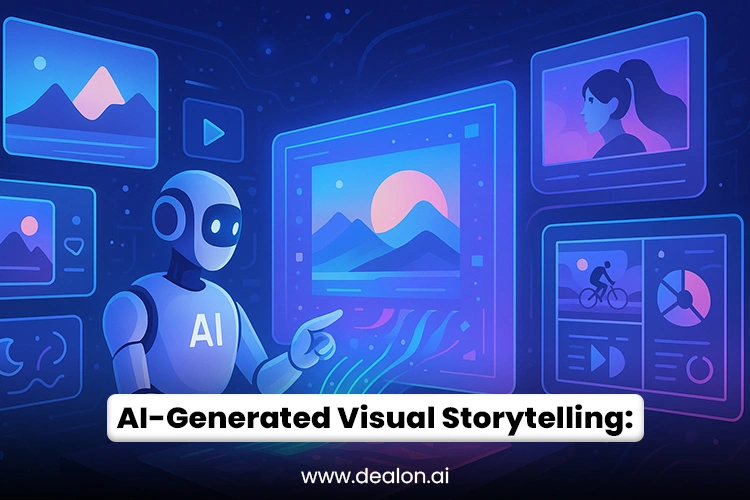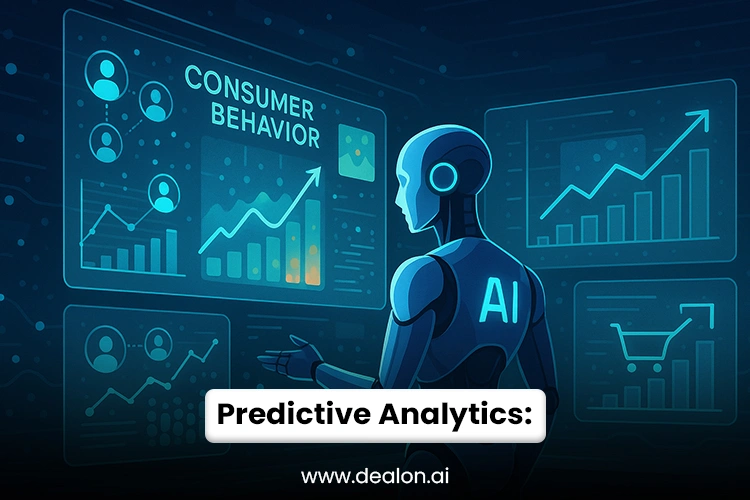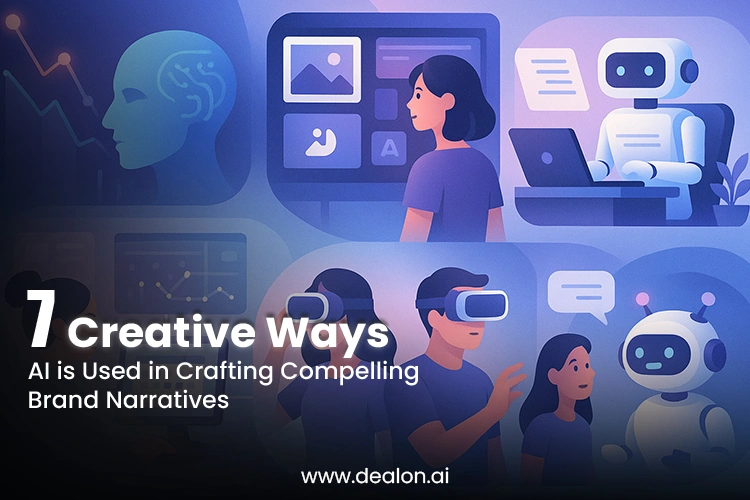In the digital age, crafting a compelling brand narrative has become an essential cornerstone of effective marketing. Consumers no longer respond to generic, one-size-fits-all messaging; they seek brands that tell authentic, meaningful stories that resonate personally. This evolution in consumer expectations has placed immense pressure on brands to innovate in their storytelling approaches. Enter artificial intelligence (AI)—a transformative force reshaping how companies create, deliver, and personalize their brand narratives.
AI empowers brands to connect with audiences through highly customized, data-driven content that speaks directly to their interests, emotions, and values. With the capacity to analyze extensive amounts of consumer data, predict behaviors, and generate compelling visuals and text, AI unlocks new levels of creativity and precision in brand storytelling. The traditional boundaries of content creation are expanding, allowing brands to craft more engaging narratives that align with consumer expectations.
Also Read: Leveraging AI for Brand Identity: How Chatbots Reinforce Brand Voice and Personality In 2025
Personalized Content Creation: AI Tailors Your Story

In the realm of brand narratives, personalization has become the gold standard. AI is driving this shift by enabling brands to craft narratives that resonate on an individual level. By harnessing the power of big data and sophisticated algorithms, AI analyzes vast arrays of consumer information, such as browsing behavior, purchase history, and even social media activity, to uncover nuanced insights into customer preferences and desires. With this wealth of data, AI empowers brands to develop highly personalized content that speaks straight to the individual.
AI’s ability to tailor brand narratives goes beyond simple customization. Through machine learning and NLP, AI can dynamically adjust the tone, style, and substance of messages depending on the audience. Whether crafting personalized email campaigns, dynamically updating website content, or generating custom social media posts, AI ensures that each piece of content feels uniquely relevant and timely. This level of personalization creates a deeper emotional connection with consumers, making them feel seen and understood by the brand.
Moreover, AI’s real-time capabilities allow brands to adapt their messaging continually. AI can adjust the brand narrative as customer behaviors evolve, ensuring it remains aligned with current interests and needs. For example, suppose a consumer shows interest in a particular product. In that case, AI can automatically present tailored content highlighting related items or offers, thus keeping the brand narrative fluid and engaging.
AI-Generated Visual Storytelling: The Power of Images

In the modern landscape of brand narratives, visuals have become paramount in engaging audiences and conveying impactful messages. AI is pushing the boundaries of what is possible in visual storytelling, enabling brands to create static images and dynamic, immersive experiences that captivate the viewer. AI-powered tools can generate realistic images, videos, and virtual environments that align seamlessly with a brand’s narrative, ensuring consistency and emotional resonance.
Using machine learning algorithms, AI can analyze a brand’s historical campaigns and consumer interactions to identify which visual elements—such as color schemes, design styles, or specific imagery—engage the target audience most effectively. This enables AI to generate aesthetically pleasing visuals and is highly attuned to the audience’s emotional triggers.
AI is also revolutionizing the role of user-generated content (UGC) in brand narratives. Through advanced pattern recognition, AI can sift through vast amounts of consumer-generated content on social media, review sites, and other platforms to identify pieces that align with the brand’s tone and ethos. AI amplifies the narrative’s authenticity by curating UGC that speaks to the brand’s values. Showcasing these real, unfiltered moments from consumers deepens the connection between the brand and its audience, adding an organic layer of credibility to the overall narrative.
Moreover, AI-driven visual storytelling is not limited to the brand’s controlled content. It extends to real-time, interactive visual experiences—whether through augmented reality (AR) or immersive environments—allowing customers to actively engage with and shape the narrative. This interactive dimension creates a dynamic feedback loop, where consumers don’t just passively consume the brand story but actively contribute to it, making the narrative a two-way conversation. By harnessing AI to craft visually stunning and emotionally engaging content, brands tell their stories and live them alongside their customers.
Predictive Analytics: Anticipating Consumer Behavior

Understanding and anticipating consumer behavior is a game-changer in the sophisticated realm of brand narratives. Predictive analytics, fueled by the prowess of AI, equips brands with the ability to foresee trends, preferences, and purchasing patterns with unparalleled precision.
Unlike traditional methods of audience analysis, predictive analytics thrives on dynamic data streams, allowing it to identify subtle behavioral shifts and emerging trends. For example, an e-commerce brand leveraging AI may detect a rising interest in sustainable products among its consumers. Armed with this foresight, the brand can weave sustainability into its narrative, launching campaigns that align with the evolving values of its audience.
Predictive analytics is incredibly transformative in addressing consumer pain points proactively. By identifying customer complaints or dissatisfaction patterns, brands can preemptively offer solutions, positioning themselves as empathetic problem-solvers. For instance, a travel company noticing increased demand for flexible booking options during uncertain times can adjust its messaging and offerings accordingly, ensuring its narrative remains relevant and responsive.
Moreover, AI’s ability to predict behavior fosters precision in campaign timing. By anticipating when consumers will likely engage, brands can deploy timely and impactful stories. Whether a product launch is aligned with seasonal demand or a marketing push tied to cultural trends, predictive analytics ensures that every narrative element aligns seamlessly with audience expectations.
Ultimately, predictive analytics transforms brand narratives into living, adaptive entities. It bridges the gap between past consumer behavior and future aspirations, enabling brands to remain relevant and indispensable. By infusing storytelling with foresight, AI empowers brands to craft narratives that are as forward-thinking as they are compelling.
Natural Language Processing (NLP): AI Enhances the Voice of Your Brand
A cohesive and authentic voice is the cornerstone of compelling brand narratives, shaping how audiences perceive and connect with a brand. Natural Language Processing (NLP), a cutting-edge subset of AI, is revolutionizing how brands craft and refine their messaging. By leveraging advanced language understanding and generation capabilities, NLP ensures that every communication aligns seamlessly with a brand’s tone, style, and overarching objectives.
For instance, an eco-conscious brand can utilize NLP to craft blog posts, social media updates, and marketing emails that consistently emphasize sustainability in a tone that reflects its mission-driven ethos. This ensures a unified narrative across all touchpoints, from the website to customer service interactions.
Chatbot technology and automated customer service represent one of the most impactful uses of natural language processing (NLP) today. AI-powered chatbots can engage customers in natural, emotionally intelligent conversations, offering personalized recommendations, resolving queries, or even sharing promotional content—all while maintaining the brand’s distinctive voice. This humanized approach strengthens the brand’s and its audience’s connection, fostering trust and loyalty.
Moreover, NLP enhances storytelling by enabling real-time sentiment analysis. Brands can gauge audience reactions to content, adapting messaging to maintain emotional resonance. For example, if an NLP tool detects lukewarm responses to a social media campaign, it can recommend adjustments to the tone or focus to reengage audiences.
By integrating NLP into their communication strategies, brands can transcend generic messaging, delivering consistent and meaningful narratives. In this way, NLP transforms brand narratives into a symphony of tailored, impactful, and emotionally compelling interactions, creating a lasting impression in the minds of consumers.
Interactive Storytelling: Immersive Experiences with AI
In the evolving landscape of brand narratives, interactive storytelling has emerged as a transformative strategy, enabling brands to engage audiences on a deeply immersive level. Powering innovative technologies like virtual reality (VR) and augmented reality (AR) to craft personalized, dynamic narratives that captivate and resonate.
AI-driven AR applications allow consumers to engage with products or services through experiential, narrative-driven interactions. For instance, a furniture brand might enable users to visualize how a sofa fits into their living room through an AR app, weaving the experience into a compelling story about enhancing their living space. Such personalized narratives inform and emotionally connect with the audience, fostering loyalty and trust.
VR elevates this interaction further by transporting users into entirely virtual worlds crafted around the brand’s story. Imagine a travel company immersing potential customers in a simulated tropical paradise, where they can explore resorts and activities firsthand. AI adapts these experiences in real time, tailoring the narrative based on user behavior and preferences, creating a sense of agency and deeper engagement.
By integrating AI into interactive storytelling, brands can transcend traditional communication methods, offering experiences that are not just seen or heard but lived—turning narratives into unforgettable, participatory journeys.
AI-Driven Audience Insights: Data-Backed Storytelling
In the intricate art of crafting impactful brand narratives, data-driven storytelling has become a cornerstone, with AI as the architect behind these precision-crafted tales. By analyzing vast datasets, AI unearths nuanced insights into audience behaviors, preferences, and emotional drivers, empowering brands to tell stories that deeply resonate with their target demographic.
AI’s ability to decode consumer sentiment and uncover hidden patterns transforms storytelling into an evidence-based endeavor. For instance, a beauty brand could leverage AI to identify rising consumer interest in clean, sustainable products. Using this insight, the brand can weave a narrative celebrating its eco-friendly practices, fostering an emotional connection with environmentally conscious customers.
Furthermore, AI’s predictive analytics refine storytelling by anticipating future audience needs and preferences. Instead of reactive messaging, brands can adopt a proactive approach, ensuring their narratives remain relevant and compelling. For example, identifying pain points—like the inconvenience of complicated return policies—allows brands to address these issues preemptively, positioning themselves as empathetic problem-solvers.
By aligning stories with consumer desires and leveraging AI’s ability to deliver hyper-relevant insights, brands elevate their narratives from generic messaging to personalized, emotionally resonant experiences. This data-backed approach doesn’t just inform—it inspires, transforming customer engagement into meaningful brand affinity.
Automation of Narrative Deployment: AI for Streamlined Storytelling
In today’s fast-paced digital environment, the success of a brand narrative hinges not only on its creativity but also on its timely and effective delivery. AI has revolutionized the deployment process, enabling brands to automate content distribution and strategically amplify their stories across various channels.
AI-powered automation tools ensure brand narratives reach the right audience at the right time. By leveraging sophisticated algorithms, these tools analyze audience behaviors and engagement patterns to optimize the timing and platform for content dissemination. For instance, an AI-driven social media scheduler can identify peak engagement periods for specific demographics, ensuring posts resonate with maximum impact. Similarly, personalized email campaigns can be automatically tailored and timed to align with individual user preferences, boosting open rates and fostering stronger connections.
Beyond distribution, AI excels in monitoring and adapting narratives in real time. By analyzing performance metrics—such as click-through rates, dwell times, and audience feedback—AI provides actionable insights to refine storytelling strategies dynamically. For example, AI can suggest tone, visuals, or timing adjustments if a campaign underperforms, ensuring the narrative evolves with audience expectations. By automating deployment and optimizing engagement, AI transforms storytelling into a seamless, data-driven process, empowering brands to deliver impactful, cohesive narratives with precision and efficiency.
Conclusion
The evolution of brand narratives has reached an unprecedented level of sophistication thanks to the transformative power of artificial intelligence. By weaving creativity with data-driven precision, AI empowers brands to craft and deliver stories that captivate, resonate, and endure. From personalized content creation that speaks to individual preferences to AI-generated visuals that evoke powerful emotional connections, the potential for storytelling innovation is limitless.
Predictive analytics enables brands to anticipate audience behaviors, ensuring their narratives remain relevant and proactive. Natural Language Processing refines a brand’s voice, aligning it seamlessly with the audience’s expectations while preserving authenticity. Interactive storytelling, enhanced through immersive experiences like AR and VR, elevates consumer engagement by turning passive viewers into active participants.
Moreover, AI-driven audience insights transform abstract data into actionable storytelling strategies, making every narrative purposeful and emotionally compelling. Finally, automation streamlines the deployment process, ensuring that stories are delivered precisely and dynamically to real-time feedback.
AI is not merely a tool but a creative collaborator, revolutionizing how brands connect with their audiences. By embracing these seven innovative approaches, companies can craft memorable narratives that drive deeper engagement, loyalty, and impact in a competitive digital era.

